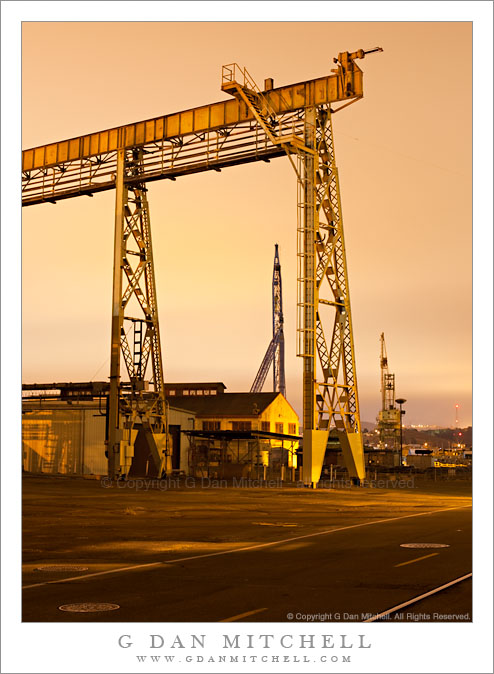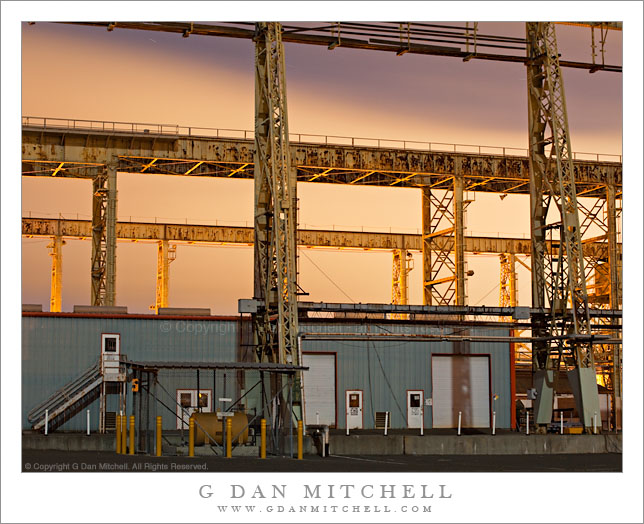Shipbuilding Yard Towers, Night. Mare Island Naval Shipyard, Vallejo, California. August 31, 2009. © Copyright G Dan Mitchell – all rights reserved.
High fog across the night sky above towers at the Mare Island Naval Shipyard, Vallejo, California.
I’ve had the good fortune to be able to do night photography at the historic Mare Island Naval Shipyard in Vallejo, California on a number of occasions over the past few years – largely because I discovered The Nocturnes, the SF Bay Area night photography group run by Tim Baskerville. (If you are looking for night photography events, workshops, and general information – you would do well to visit their web site.) The Nocturnes photograph regularly at Mare Island (also known as “MINSY”) and I got my first, ahem, exposure to night photography via one of their events.
This visit, on the final night of August, was the first time I’ve shot there when it wasn’t an event sponsored by The Nocturnes, and it seemed a bit odd to be the person most experienced at shooting here. This event was more or less organized by SF Bay Area photographer Ivan Makarov who contacted me ahead of time for some information about shooting at MINSY and invited me to join his group if I could. I could, so I did.
After shooting there a half dozen times or so, it starts to seem a bit too easy to keep shooting the same Mare Island icons in the same way, so this time I decided to try to shoot a few things that I had not shot before and to shoot some of the familiar subjects in somewhat different ways. One decision I made was to – for the most part – avoid the usual super-wide-angle shots that seem so obvious in this environment. I started out using a 70-200mm zoom instead and later moved to shooting with normal to slightly long primes. (I did fall back on the UWA approach for a few shots – heck, if it works I’m going to do it!) Another factor was that we did not have the totally clear full-moon skies that I’m more familiar with from previous MINSY shoots. We had a softer but earlier 3/4 moon, and at times there was quite dense high fog. The fog obviously obscures the sky and reduces/eliminates the star trail photographs, but it also picks up and then spreads a wonderful diffuse light from the many natural and artificial light sources found at MINSY.
The photograph shown here was made with the long zoom and includes nearly complete fog coverage of the sky. The lighting is a crazy combination of light from nearby Vallejo reflected in the clouds, garish sodium vapor lighting coming from beyond the scaffolding, and some “natural” light from the moon on the front of the metal building. (One of the things I enjoy about night photography in a location like this is that with so many wildly different light sources there is no correct color balance – so I get to pick!
This photograph is not in the public domain. It may not be used on websites, blogs, or in any other media without explicit advance permission from G Dan Mitchell.
Web: G Dan Mitchell Photography
Twitter: http://twitter.com/gdanmitchell
Friendfeed: http://friendfeed.com/gdanmitchell
Facebook: http://www.facebook.com/gdanmitchell
keywords: minsy, mare, island, naval, ship, yard, historic, vallejo, california, tower, steel, truss, equipment, industrial, bridge, star, trail, fog, light, building, shack, loading, dock, door, window, stairs, steps, asphalt, wire, rust, worn, abandoned, stock, tall, shadow, night, photography, nocturnal, metal, concrete, cement, glow, yellow
Like this:
Like Loading...


